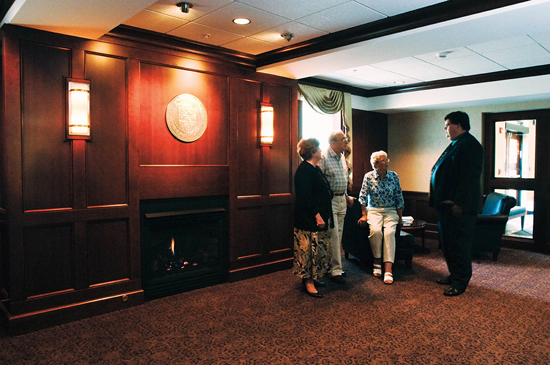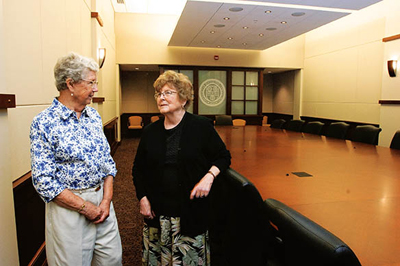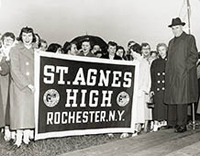

A New Home for the Rochester Family
Rochester dedicates a new center for alumni and advancement programs.
Photography by Richard Baker
Text by Scott Hauser
As alumni, friends, and families return to campus this fall for Meliora Weekend, they will find a new “home base” to help them stay connected to the University and to each other.
This fall the University opens a new alumni and advancement center designed as a national headquarters in service to alumni, parents, and friends of the University. The newly renovated building features meeting spaces, reception areas, and other facilities that can be used for organizational meetings and other events.

RECEPTION: Nancy Jones Lyke ’47, ’73W (Mas), Peter DiPasquale ’52, and Jean Conner Ferris ’47 talk with Kevin Wesley, executive director of alumni relations.
“The new center recognizes the importance of alumni, parents, friends, and community leaders in the life of the University,” says Jim Thompson, senior vice president and chief advancement officer. “Their connection to the University can and should be lifelong. Whether they are volunteer leaders returning to work on a committee or visitors returning to campus to catch up with friends, the facility will be a welcoming and comfortable home.”

NEW ROOMS: Jean Conner Ferris ’47 and Nancy Jones Lyke ’47, ’73W (Mas) catch up in the new board conference room, which is used by a variety of volunteer leadership groups for organizational meetings.
Alumni Dedication
The grounds surrounding the new alumni and advancement center will be formally dedicated during Meliora Weekend in honor of Elmer B. Milliman, a member of the Class of 1919.
Milliman, a former president of Central Trust Company and former chairman of the board of Rochester Management Inc., was an active Rochester civic leader and a former trustee of the University.
The new building also recognizes former trustee Matthew Fairbank ’30, ’35M (MD) and his wife, Ruth Harmon Fairbank ’31. The former home of many of Rochester’s alumni programs was named in their honor in 1980. The center’s primary event space, the Fairbank Lounge, is named for them.
Located on the grounds of the former St. Agnes High School, a property that the University has owned since 1982, the center brings the organizations and programs responsible for advancement under one umbrella.
During Meliora Weekend, the new center will be the site of a number of events, including Board of Trustees meetings, a reception, and student performances. Alumni and friends of all the University’s schools and units are invited to think of the new center as theirs.
“The center is really the best of all possible worlds,” says Kevin Wesley, executive director of alumni relations. “It has wonderful formal space and a warm atmosphere. The space allows alumni to have a home away from home when visiting campus, whether for a committee meeting, a formal alumni event, or simply to browse through yearbooks. Come by, have a cup of coffee, and say hello!”
What Became of St. Agnes?

OLD SCHOOL: Opened in 1954, St. Agnes High School closed in 1982, and the University purchased the property.
At about the same time as women students at the University were preparing to move from the Prince Street campus to the then newly built River Campus, there were other, younger Rochester girls getting ready for a momentous change of their own.
In the fall of 1954, the doors opened at St. Agnes High School, a new home for a Catholic school originally founded in 1906 as the St. Agnes Institute of Art and Music. Named in honor of Mother Agnes Hines, superior general of the Sisters of St. Joseph from 1882 until 1921, the new school on East River Road was one of several built by the diocese in response to growing student enrollment after World War II.
Outgrowing their site in downtown Rochester, the Sisters of St. Joseph in 1948 had purchased 37 acres south of the River Campus. In 1953, ground was broken for the 800-student school, which also included a chapel and a convent for the sisters who taught there.
When the order closed St. Agnes in June 1982, the University, which had already bought some of the original land as a site for graduate student housing, purchased the remaining land, including the school and its buildings.
Since then, the site has been used by the University for a variety of programs. This summer, with renovations completed on many of the buildings, the old St. Agnes school was reborn as the University’s new home for alumni and advancement programs.
—Scott Hauser
